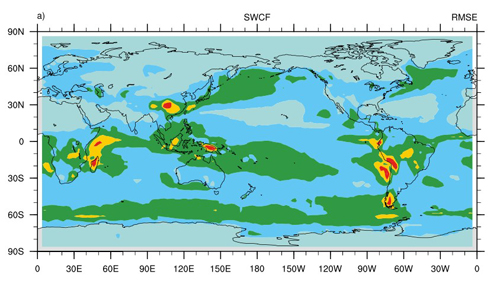A series of studies by IAP scientists reveal the important connection between stratus formation and ambient environment
Date:2014-11-24
Cloud is one of the most fundamental regulators in the earth system. It has great impact on both the radiative balance and hydrological cycle. Current state-of-the-art atmospheric general circulation models (AGCMs) have large discrepancies in simulating the shortwave cloud radiative forcing generated by the cold-season stratus clouds over eastern China (Fig.1), limiting the ability of models in simulating the local climate, constituting an urgent need for improvement.
ZHANG Yi at the Institute of Atmospheric Physics, Chinese Academy of Sciences, supervised by Prof. YU Rucong, investigated this problem from both the observational and modeling aspects. Their study reveals the important connection between stratus formation and ambient environment (Fig.2), indicating that circulation induced moisture and stable environment downstream of the Tibetan Plateau is a key reason that leads to the formation of stratus clouds. Current AGCMs cannot adequately simulate the stratus shortwave cloud radiative effect just due to the fact that they fail to reasonably represent the ambient environment. The study further explores the idea using some numerical experiments, including changing the horizontal resolution, ambient environment and dynamical core of a given AGCM. The results confirm that eliminating the errors of ambient environment can effectively improve the stratus simulation. Results also suggest that a high-resolution AGCM can help to improve the simulations of stratus clouds just because they can provide a more reasonable ambient environment.

Fig.1 RMSE errors of simulated shortwave cloud radiative forcing (W m-2) in CMIP5 models against the observation

Fig.2 The ambient environment associated with stratus formation, including top: circulation fields (white contour indicates meridional wind, vector indicates the composite of zonal wind and vertical velocity), temperature field (color) and bottom: specific humidity.
This series of work has been published in:
Zhang, Y., R. Yu, J. Li, W. Yuan, and M. Zhang, 2013: Dynamic and Thermodynamic Relations of Distinctive Stratus Clouds on the Lee Side of the Tibetan Plateau in the Cold Season. Journal of Climate, 26, 8378-8391.
Zhang, Y., and J. Li, 2013: Shortwave cloud radiative forcing on major stratus cloud regions in AMIP-type simulations of CMIP3 and CMIP5 models. Adv. Atmos. Sci., 30(3), 884–907.
Zhang, Y., H. Chen, and R. Yu, 2014: Vertical Structures and Physical Properties of the Cold-Season Stratus Clouds Downstream of the Tibetan Plateau: Differences between Daytime and Nighttime. Journal of Climate, 27, 6857-6876.
Zhang, Y., H. Chen, and R. Yu, 2014: Simulations of Stratus Clouds over Eastern China in CAM5: Sensitivity to Horizontal Resolution. Journal of Climate, 27, 7033-7052.
Zhang, Y., H. Chen, and R. Yu, 2014: Simulations of stratus clouds over eastern China in CAM5: Sources of errors. Journal of Climate. doi: 10.1175/JCLI-D-14-00350.1, in press.
